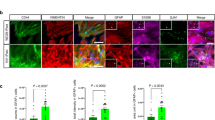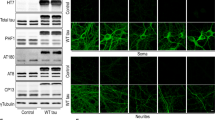Abstract
Parkinson’s disease (PD) mainly results from the progressive loss of dopaminergic (DA) neurons in the substantia nigra pars compacta (SNpc), and the exact underlying mechanisms of the loss of DA neurons in PD remains largely unclear. The results of our previous work showed that let-7d was significantly downregulated in a 6-OHDA-induced cellular model of PD. However, the exact effect of let-7d on DA neural cells was unclear. In MN9D dopaminergic neuronal cells, we used a let-7d mimic and inhibitor to upregulate and downregulate the expression of let-7d, respectively, a cell counting kit to assess cell viability, and a TUNEL staining assay and flow cytometry to examine the cell death rate, and we found that let-7d could negatively regulate 6-OHDA-induced cell injury. Then, we verified that caspase-3 was a target gene of let-7d by using a dual-luciferase reporter system. Furthermore, using caspase-3 siRNA and a caspase-3-overexpression vector (without the 3′UTR) to respectively inhibit and increase the expression of caspase-3, we found that caspase-3 siRNA could reverse the cell injury induced by the let-7d inhibitor and that caspase-3 overexpression could reverse the protective effects of the let-7d mimic on 6-OHDA-induced cell injury. Taken together, these findings strongly suggest that let-7d plays an important role in DA neuronal cell injury and that the effects of let-7d are, at least in part, via the suppression of caspase-3 expression.






Similar content being viewed by others
References
Andersen JK (2001) Does neuronal loss in Parkinson’s disease involve programmed cell death? BioEssays 23:640–646
Bartel DP (2004) MicroRNAs: genomics, biogenesis, mechanism, and function. Cell 116:281–297
Bogaerts V, Theuns J, van Broeckhoven C (2008) Genetic findings in Parkinson's disease and translation into treatment: a leading role for mitochondria? Genes Brain Behav 7:129–151
Chaudhry ZL, Ahmed BY (2013) Caspase-2 and caspase-8 trigger caspase-3 activation following 6-OHDA-induced stress inhuman dopaminergic neurons differentiated from ReNVM stem cells. Neurol Res 35:435–440
Chen CX, Huang SY, Zhang L, Liu YJ (2005) Synaptophysin enhances the neuroprotection of VMAT2 in MPP+-induced toxicity in MN9D cells. Neurobiol Dis 19:419–426
Christensen M, Schratt GM (2009) microRNA involvement in developmental and functional aspects of the nervous system and in neurological diseases. Neurosci Lett 466:55–62
Ciron C, Lu Z, Bobela W, Knott GW, Leone TC, Kelly DP, Schneider BL (2015) PGC-1α activity in nigral dopamine neurons determines vulnerability to α-synuclein. Acta Neuropathol Commun 3:16
Cohen GM (1997) Caspases: the executioners of apoptosis. Biochem J 326(Pt 1):1–16
Cookson MR (2005) The biochemistry of Parkinson’s disease. Annu Rev Biochem 74:29–52
Cryns V, Yuan J (1998) Proteases to die for. Genes Dev 12:1551–1570
Di Fiore R, Drago-Ferrante R, Pentimalli F, Di Marzo D, Forte IM, Carlisi D, De Blasio A, Tesoriere G, Giordano A, Vento R (2016) Let-7d miRNA shows both antioncogenic and oncogenic functions in osteosarcoma-derived 3AB-OS cancer stem cells. J Cell Physiol 231:1832–1841
Ding YM, Jaumotte JD, Signore AP, Zigmond MJ (2004) Effects of 6-hydroxydopamine on primary cultures of substantia nigra: specific damage to dopamine neurons and the impact of glial cell line-derived neurotrophic factor. J Neurochem 89:776–787
Green DR, Llambi F (2015) Cell death signaling. Cold Spring Harb Perspect Biol 7:a006080
Holtz WA, Turetzky JM, O'Malley KL (2005) Microarray expression profiling identifies early signaling transcripts associated with 6-OHDA-induced dopaminergic cell death. Antioxid Redox Signal 7:639–648
Kalia LV, Lang AE (2015) Parkinson’s disease. Lancet 386:896–912
Kroemer G, Blomgren K (2007) Mitochondrial cell death control in familial Parkinson disease. PLoS Biol 5(7):1409–1411
Li L, Chen HZ, Chen FF, Feng L, Meng W, Li W, Li YQ, Gao DS (2013) Global microRNA expression profiling reveals differential expression of target genes in 6-hydroxydopamine-injured MN9D cells. NeuroMolecular Med 15:593–604
Liang H, Li X, Wang L, Yu S, Xu Z, Gu Y, Pan Z, Li T, Hu M, Cui H, Liu X, Zhang Y, Xu C, Guo R, Lu Y, Yang B, Shan H (2013) MicroRNAs contribute to promyelocyte apoptosis in As2O3-treated APL cells. Cell Physiol Biochem 32:1818–1829
Mouradian MM (2012) MicroRNAs in Parkinson's disease. Neurobiol Dis 46:279–284
Nuovo GJ, Garofalo M, Valeri N, Roulstone V, Volinia S, Cohn DE, Phelps M, Harrington KJ, Vile R, Melcher A, Galanis E, Sehl S, Adair R, Scott K, Rose A, Toogood G, Coffey MC (2012) Reovirus-associated reduction of microRNA-let-7d is related to the increased apoptotic death of cancer cells in clinical samples. Mod Pathol 25:1333–1344
Persengiev S, Kondova I, Otting N, Koeppen AH, Bontrop RE (2011) Genome-wide analysis of miRNA expression reveals a potential role for miR-144 in brain aging and spinocerebellar ataxia pathogenesis. Neurobiol Aging 32:2316.e17–2316.e27
Rodriguez-Oroz MC, Jahanshahi M, Krack P, Litvan I, Macias R, Bezard E, Obeso JA (2009) Initial clinical manifestations of Parkinson’s disease: features and pathophysiological mechanisms. Lancet Neurol 8:1128–1139
Schapira AH, Jenner P (2011) Etiology and pathogenesis of Parkinson’s disease. Mov Disord 26:1049–1055
Schratt G (2009) Fine-tuning neural gene expression with microRNAs. Curr Opin Neurobiol 19:213–219
Schratt GM, Tuebing F, Nigh EA, Kane CG, Sabatini ME, Kiebler M, Greenberg ME (2006) A brain-specific microRNA regulates dendritic spine development. Nature 439:283–289
Shimizu S, Takehara T, Hikita H, Kodama T, Miyagi T, Hosui A, Tatsumi T, Ishida H, Noda T, Nagano H, Doki Y, Mori M, Hayashi N (2010) The let-7 family of microRNAs inhibits Bcl-xL expression and potentiates sorafenib-induced apoptosis in human hepatocellular carcinoma. J Hepatol 52:698–704
Signore AP, Weng Z, Hastings T, Van Laar AD, Liang Q, Lee YJ, Chen J (2006) Erythropoietin protects against 6-hydroxydopamine-induced dopaminergic cell death. J Neurochem 96:428–443
Vo N, Klein ME, Varlamova O, Keller DM, Yamamoto T, Goodman RH, Impey S (2005) A cAMP-response element binding protein-induced microRNA regulates neuronal morphogenesis. Proc Natl Acad Sci U S A 102:16426–16431
Acknowledgements
This work was funded by the National Natural Science Foundation of China (Grant number: 81401056), Jiangsu provincial government scholarship program, and Xuzhou Science and Technology Project (KC14SH083).
Author information
Authors and Affiliations
Corresponding author
Ethics declarations
Conflict of Interest
The authors declare that they have no conflicts of interest.
Rights and permissions
About this article
Cite this article
Li, L., Liu, H., Song, H. et al. Let-7d microRNA Attenuates 6-OHDA-Induced Injury by Targeting Caspase-3 in MN9D Cells. J Mol Neurosci 63, 403–411 (2017). https://doi.org/10.1007/s12031-017-0994-x
Received:
Accepted:
Published:
Issue Date:
DOI: https://doi.org/10.1007/s12031-017-0994-x




